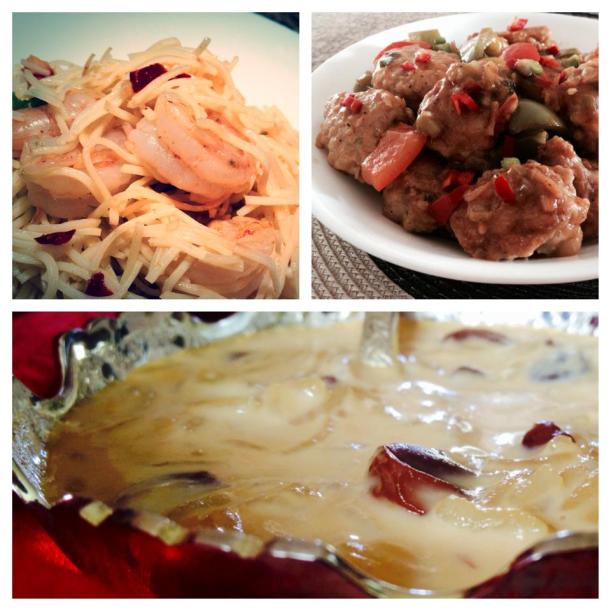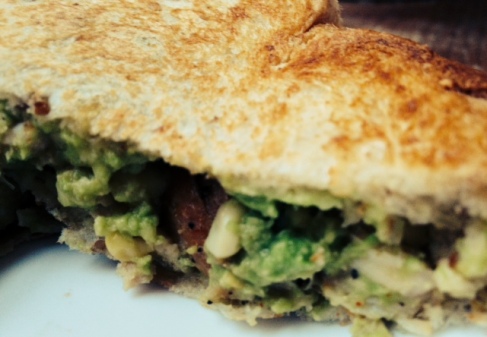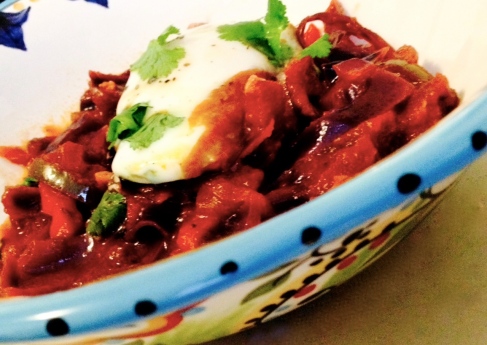Category Archives: Non-vegetarian
Home Alone: Murg Palak
I am home alone this holiday weekend, all thanks to JetBlue airlines. As flies to wanton boys, are we to the airline personnel.
I was supposed to fly to Tampa today to meet a friend after five years. I had booked myself on a direct JetBlue flight from Boston, a month back. But yesterday morning I received an email from JetBlue saying that my flight might get cancelled or delayed due to the impending hurricane, Arthur. I was given the option to reschedule at no additional cost. So I did. I re-booked myself on a flight with one stop, connecting in JFK, on the 2nd of July.
It was already noon and the flight was scheduled to leave from Boston at 2.43 p.m. I somehow managed to pack my bags and called a cab and reached Logan on time. I boarded the flight feeling happy and excited.
I had a 3.5 hours layover at JFK. The flight was scheduled to leave at 7.30 p.m. It got delayed first by an hour, then by another. I was getting impatient. So were the other passengers. Several JetBlue flights were delayed and some cancelled. I feared the worst. I was tired and hungry; all I wanted was to board flight 225 to Tampa. JetBlue officials announced the flight was coming in from Charlotte, NC and hence the delay. Passengers were assured the flight would leave as soon as it came in.
The flight arrived after midnight. We boarded at 12:45 a.m. The pilot announced that the aircraft would be taxiing for 30-60 minutes due to the backlog that was created. The aircraft taxied for 40 minutes, slowly. So slowly that it would put a snail to shame.
At 1.45 a.m. came the next announcement from the pilot: one of his colleagues on the flight had exceeded his 16-hour shift limit, which was against the federal regulations. He therefore would have to steer the plane back to the gate. And then came the bad news, the flight was cancelled. I am happy to know that JetBlue cares about their employees but what about their customers?
We deplaned. I was tired and angry like the others. We had to collect our baggage and had to re-book at JetBlue check-in counters. I stood in the serpentine line for three hours (2 a.m to 5 a.m.) The officials said that they couldn’t guarantee us a seat on the next flight to Tampa. I tried calling the customer service number several times, but to no avail.
The line wasn’t moving at all. I felt trapped and feared that I would never be able to leave the airport. I just wanted to get back home at that point. I hadn’t eaten for hours and had no more energy left to put up a fight. I took a cab to Penn station and bought a train ticket to Boston. I reached Boston today at 10.30 a.m. Cab + train fare = $245.
My husband is flying to Atlanta today to meet his friends. He had an evening Delta flight, which got delayed by few hours. He has now boarded the flight but there seems to be some kind of problem with the aircraft door and they are repairing it; that’s the latest update. I sincerely hope he doesn’t have to go through the same ordeal as I did.
On a lighter note, with all the time that I have now, I got to experiment in the kitchen today. I made chicken (murg) in a spinach (palak) gravy. I marinated the chicken pieces with ginger-garlic paste, cajun spice, tandoori masala, yogurt, oil, garam masala, salt & pepper. Then I pan fried it. For the gravy, I blanched a packet of baby spinach and stirred it in with some onion, tomato/tomato paste, ginger, garlic and green chilies that I was frying in a skillet and then pureed it in a blender. Then I added in the chicken pieces to the gravy.
Tandoori Chicken: For the butcher
A couple of months back I was buying two pounds of whole chicken legs at the local Whole Foods market when the butcher, donning a soiled apron, asked me what I was planning to make. Tandoori chicken, I said. The words had piqued his interest; I could tell from his glistening eyes and arching eyebrows. When he was not butchering animals, he was recreating recipes — he is a chef — he explained. His daughter shares his culinary passion, he said with a contented smile. He then queried about the tandoori recipe.
I explained how I would prepare an aromatic marinade — with a blend of ginger-garlic-onion-green chilies-cilantro-mint-yogurt-tandoori masala-salt & pepper-lemon juice-oil and a sprinkling of home-made garam masala — and let the chicken pieces steep in it, overnight. And my secret ingredient was the addition of a couple of teaspoons of Cajun spice to the blend, which imparts a smokey flavor to the dish! The next day I would bake it in the oven, then broil it for a few minutes to give the chicken the very coveted out-of-the-tandoor look.
He said it sounded wonderful and asked me if I would mind writing it down for him. So I did; I handed him over the recipe the next time I went grocery shopping. He was delighted and as a token of his appreciation didn’t charge me for the meat I was buying.
“No way,” I said.
“I am the boss here; it won’t be a problem,” he insisted.
“In that case I will have to leave without the meat,” I said.
I had successfully butchered the argument!
He looked forward to trying out my tandoori chicken recipe with his daughter, he said. I wished him all the luck.
The sight and smell of fish make me happy!
I walked into the bustling fish market armed with the quintessential striped thole (reusable nylon grocery bag). The fish scale strewn brick lane was glistening with a Bengali’s enthusiasm for fish.
The clock had 30 minutes to strike nine but the market was heaving with customers. They had resisted the temptation to laze around the house on a Sunday morning for their greater love of fish. Fish that will eventually end up on their lunch platter – fried and slathered in gravy.
Blood and guts everywhere. Severed fish heads. Gills, fins, roe and bloody scales. The smell hovering over both obnoxious and delectable. Delectable to my Bengali palate that will wither away sans fish.
Fishmongers lined both sides of the narrow lane. Seated on a concrete platform they flaunted their day’s catch, spread on fresh green banana leaves. The tarpaulin lined asbestos roof, held upright with bamboo props, provided shade. They were straining their voices to lure patrons. The sound both mellifluous and cacophonous.
“Bhalo bhetki hobe dada, niye jan,” assured one of the fishmongers.
( The bhetki [a freshwater fish] is real good brother, take it home.)
Rui, katla, ilish, bhetki, pabda, parshe, chitol, chingri, bata, khayra, magur — fish of varying shapes, sizes and tastes. A feast for the eyes and soul; never frozen, always fresh. Some dead and some merrily alive.
The fishmonger will swiftly scale and gut the fish for you. And if you fancy a special cut for your catch, he will readily cater to your taste. The whetted boti his paintbrush, the fish his canvas; enchanting customers with his dexterity.
[My Kolkata trip would have been incomplete without a visit to my neighborhood fish market.]
Sandwich: Then and Now
Two slices of white bread, toasted atop a roti mesh or in a frying pan, crammed with lumps of refrigerated Amul butter. Granules of clear bead-like sugar, clinging on to the buttery mounds, adding a sugary crunch. This unevenly toasted, bumpy sandwich frequented my steel lunchbox during middle school years.
I have slowly graduated to grilled whole wheat sandwiches; grilled chicken sandwich with buttery avocado and sweet corn being one of my favorites. But a frying pan and a smear of butter still come in handy when it comes to toasting the sandwich.
Tunisian stew to beat the winter blues
I needed some color to brighten up this cold, snowy day. Red, green, purple, yellow and crimson — I was craving Spring!
But for now I had to make do with yellow onions, red and green peppers, purple cabbage and crimson tomatoes. They worked their magical hues to transition into this warm concoction called Chakchouka or Shakshouka, a North African dish. I came across the recipe on the NYT website and had to give it a try.
Cooking Doi Maach for a chef
Cooking for a restaurateur/chef is intimidating. Especially so when you are enlisted with the task of introducing a dish to his palate.
I met with Pushpir Bhetia — the owner of the Indian restaurant called Guru, in Somerville — in February this year for an interview, as part of my research work on Sikh immigrants in Boston.
Apart from talking about the prime issue — Sikhs being target of hate crimes in the US especially after 9/11— we talked a lot about food.
During one such conversation, we talked about fish. When you are talking about food and fish isn’t mentioned, a Bengali might quickly lose interest. Bhetia knew this. He asked me what kind of specialty fish dishes Bengalis dish out when it comes to entertaining guests.
Doi Maach, I said. Fish cooked in a yogurt-based gravy.
Pungent mustard oil is tempered with bay leaves, cardamom, cinnamon, cloves and red chilies and as soon as the warm spicy flavor hits the nose the creamy ginger-garlic-onion and tomato paste is introduced. Turmeric, cumin powder, salt and sugar goes in next and the mixture is cooked till the oil separates from the gravy. Half a cup of well beaten yogurt is then added. After cooking the mixture for a couple of minutes half-cup water is introduced to the gravy and once it comes to a boil the lightly fried pieces of rui are added. The mixture is then cooked till the desired gravy consistency is achieved. A sprinkle of garam masala and the dish is ready to be enjoyed with warm fluffy white rice.
Bhetia seemed intrigued by the recipe and I promised to bring him some doi maach once my semester was over.
My semester was over by the last week of April. I got busy doing nothing.
But yesterday I decided to act on my promise. I cooked doi maach but the whole cooking process was a bit intimidating, like I said. The thought that I was cooking for a chef kept badgering me.
Once the dish was ready I packed it carefully inside a container. When I arrived at the restaurant, Bhetia was busy cooking baingan bharta.
I handed over the doi maach to him along with the recipe. I was planning to leave but he asked me to wait, as he scooped out a spoonful of rice, from the rice cooker, on a plate.
“This is going to be my lunch today,” he said, as he opened the container I brought him.
It was like a nightmare come true; my paper was being graded right in front of me!
I stood in the kitchen as I watched him eat. It took him around ten minutes to finish the six pieces of fish that I had carefully nestled in the container for him.
“So, what’s the verdict?” I asked timidly.
Pointing towards the empty, gravy stained container he said, “Need I say more?”
Poppy seeds and a ‘high’ly joyful cook

I was reminded of this picture, I took last week, after I wrote the word ‘Zen’. The word evoked images of green tea and chopsticks.
I had once watched a documentary called “How to Cook your Life”. The person being documented — Edward Espé Brown, a Zen cook and writer — had mentioned that “the food will taste better when the cook is joyful.”
And I strongly agree to that.
Brown had also talked about concentration — an important ingredient for cooking, according to him.
At one time the camera follows him while he preps the rice before cooking. He is seen diligently washing the rice, almost grain by grain.

Poppy seeds acquire a wet sand-like texture
after grinding them in a blender. No water was added during the process.
But I am the type of cook whose mind wanders [a lot] during cooking. The blazing burner reminds me of bonfires; the hot oven of a sauna; the variegated spices of the spring colors of Holi; and the list continues.
Today, for instance, while I was grinding poppy seeds, the star ingredient for the chicken dish I was preparing, my mind began to wander.
As I watched the blender grind the poppy seeds, the picture of a pristine sandy beach flashed across my mind. I could almost feel my feet pressing against the wet sand.
The thought of it made me [the cook] joyful and I was all set to prepare Chicken Posto.
Note: Posto is Bengali for poppy seeds.

A rich and flavorful dish with a creamy texture.Recipe: Prepare the marinade with ground poppy seeds, yogurt, ground cashew nut, onion-garlic-ginger-green chilli paste, salt & sugar. Let the chicken pieces marinate for at least 30 mins before cooking. Add oil to a hot pan and a dried red chilli and add in the chicken along with the marinade. Add dried fenugreek leaves just before turning off the burner.
Shortcut to Haleem
Today I cooked haleem for the first time.
For those who are not familiar with haleem, it is an uber-flavorful dish made of meat, spices, lentils and cracked wheat and has a soup-like consistency.
“During the holy month of Ramzan, Muslim brethren go on fast from dawn to dusk and relish the steaming Haleem to break their fast during Iftaar (evenings).”
The dish originated in Iran and Afghanistan, and was brought to India during the Moghul regime. Haleem in Arabic means ‘patient’, and rightly so. When prepared the authentic way, it takes a minimum of six to eight hours to cook. You sure need a lot of patience for that!
You need to watch this video to understand how labor-intensive the authentic preparation can be. The video documents cooks preparing 220 lb. of haleem at a restaurant in Hyderabad, India.
I am the kind who wouldn’t labor for over six hours to prepare haleem or any other dish. I would rather invest that time in locating a restaurant who would do it for me. Here in Boston, Darul Kabab, a Bangladeshi restaurant satiates my love for haleem.
But today afternoon I decided to prepare haleem, my way and that means I didn’t look up recipes on the Internet. I used ingredients that were available in the pantry. I think the weather today played a huge role in fueling my desire to prepare the dish. It was raining, it still is, and I was craving for a warm and flavorful dish sporting a thick soupy consistency.
I didn’t have cracked wheat so it would just be a medley of lentils — masoor, moong,
chana and urad dal — spices — coriander powder, cumin powder, turmeric, red chili powder, dried red chili, curry powder, bay leaves, cinnamon, cardamom, cloves, star anise and shah jeera — chunks of goat meat and a paste of ginger, garlic, green chili and onion. I also didn’t have tomato or tomato paste so I used ketchup instead. And lastly salt and sugar to taste.
The best part of coming up with your own recipe *** use whatever is available and substitute or leave out ingredients as you wish. Also you can just eyeball the measurements.***
It took me about an hour and half to cook the dish; the credit goes to my six-year-old pressure cooker.
After adding a mixture of olive oil and butter (generally ghee is used) I threw in the whole spices and then added the ginger-onion-garlic-green chili paste in the pressure cooker. The powdered spices and the goat meat went in next along with the Heinz ketchup. When the oil began to separate I added the pre-washed lentils and stirred it for a while before adding water, at least four to five cups.
After closing the lid of the pressure cooker, I let it simmer for about an hour. Then I cranked up the burner and after seven whistles turned it off.
I let it rest for a while and when I opened the lid of the pressure cooker, a waft of flavor that stirs in temptation began lurking in the kitchen.
I squeezed in juice from half a lemon, as a final touch, and there it was — my shortcut haleem. And I didn’t even have to compromise with the taste! If I had slow cooked it for six hours the only difference would have been that the meat would have fallen off the bones and melted like the lentils. But honestly, I don’t think my jaws would mind the extra workload for that comes with a prize — saving like five hours of cooking time.
++Note the single strand of cilantro leaf in this picture, well there’s a story behind it. I opened the refrigerator and pulled out the almost forgotten two-week old bunch of cilantro leaves. All but this single one had turned yellow.










